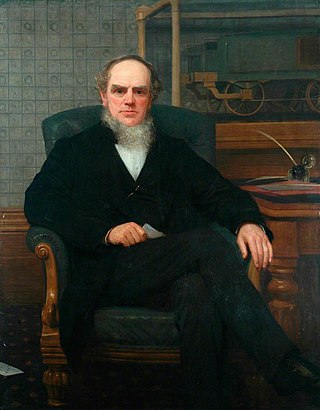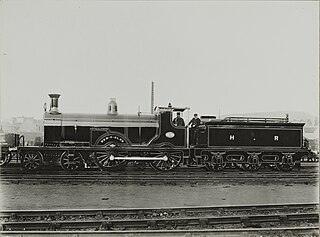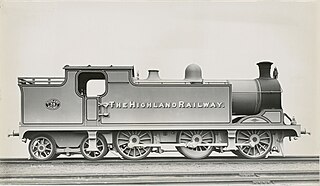Related Research Articles
Chief mechanical engineer and locomotive superintendent are titles applied by British, Australian, and New Zealand railway companies to the person ultimately responsible to the board of the company for the building and maintaining of the locomotives and rolling stock. In Britain, the post of locomotive superintendent was introduced in the late 1830s, and chief mechanical engineer in 1886.

John Ramsbottom was an English mechanical engineer. Born in Todmorden, then on the county border of Yorkshire and Lancashire. He was the Chief Mechanical Engineer for the London and North Western Railway for 14 years. He created many inventions for railways but his main legacy is the split metal piston ring, virtually all reciprocating engines continue to use these today.

The Highland Railway's Clan Goods class was a class of steam locomotive. They were designed by Christopher Cumming. The first four were built by Hawthorn Leslie and Company on Tyneside, and the maker's plates bore the date 1917, but because of wartime delays were not delivered until 1918. Four more were built in 1919, also by Hawthorn Leslie.

The Highland Railway Ben Class were small 4-4-0 passenger steam locomotives. There were actually two separate 'Ben' classes, usually referred to as the 'Small Bens' and the 'Large Bens'.

The Highland Railway K class were the only class of 0-6-0 tender locomotives built for the Highland Railway. They were introduced in 1900, to the design of Peter Drummond. The class were known as 'Barneys'.

The Highland Railway Drummond 0-6-4T or X class were large tank engines originally intended for banking duty. They were designed by Peter Drummond.
The Highland Railway River class was a class of steam locomotive with a 4-6-0 wheel arrangement. They were designed by F. G. Smith, who had joined the Highland Railway in 1904 from the North Eastern Railway. His initial post was as manager of the Locomotive, Carriage and Wagon works at Inverness. When Peter Drummond departed to the Glasgow and South Western Railway at the end of 1911 Smith was appointed Chief Mechanical Engineer in his place.
The Highland Railway E Class was a class of 4-4-0 steam locomotive designed by David Jones for passenger service. They were also known as the 'Clyde Bogies' as they were built by the Clyde Locomotive Company in Glasgow, Scotland. They were the first locomotives built by that company.
The Highland Railway W Class were four small 0-4-4T locomotives built by the Highland Railway in 1905–1906 to the design of locomotive superintendent Peter Drummond. They were the last engines that were built at the company's Lochgorm works in Inverness, and were used on branch line services.

Dugald Drummond was a Scottish steam locomotive engineer. He had a career with the North British Railway, LB&SCR, Caledonian Railway and London and South Western Railway. He was the older brother of the engineer Peter Drummond, who often followed Dugald's ideas in his own work.
Robert Wallace Urie was a Scottish locomotive engineer who was the last chief mechanical engineer of the London and South Western Railway.
George Brittain was an English railway engineer, and was Locomotive Superintendent of the Caledonian Railway from 1876 to 1882, between Benjamin Connor and Dugald Drummond.
James Stirling (1835–1917) was a Scottish mechanical engineer. He was Locomotive Superintendent of the Glasgow and South Western Railway and later the South Eastern Railway. Stirling was born on 2 October 1835, a son of Robert Stirling, rector of Galston, East Ayrshire.
The Clyde Locomotive Company was a firm of locomotive manufacturers in Springburn, Glasgow, Scotland.

The South African Railways Class 8B 4-8-0 of 1903 was a steam locomotive from the pre-Union era in Transvaal Colony.

The South African Railways Class 8C 4-8-0 of 1903 was a steam locomotive from the pre-Union era in Transvaal Colony.

Locomotives of the Caledonian Railway. The Caledonian Railway Locomotive Works were originally at Greenock but moved to St. Rollox, Glasgow, in 1856. The locomotive classes are listed under the names of the railway's Chief Mechanical Engineers.
The locomotives of the Highland Railway were used by the Highland Railway to operate its lines in the north of Scotland. The Highland Railway locomotive works was at Lochgorm, Inverness. The works had been built about 1855 by the Inverness and Nairn Railway. The locomotive classes are listed under the names of the railway's Locomotive Superintendents.

The G&SWR 45 Class were 0-6-2T steam locomotives designed by Peter Drummond for the Glasgow and South Western Railway (G&SWR) of which 18 were built in 1915-1917, followed by a further 10 of a slightly modified design in 1919 after Robert Whitelegg took over as Chief Mechanical Engineer.
The Glasgow and South Western Railway 540 Class were 4-6-4T steam tank locomotives designed by Robert Whitelegg and built in 1922, shortly before the G&SWR was absorbed into the London, Midland and Scottish Railway (LMS). They were referred to in official G&SWR publicity as the Baltic Class, although they were also known more prosaically to enginemen as the 'Big Pugs'.
References
- ↑ Baxter 1984, p. 183.
- Baxter, Bertram (1984). Baxter, David (ed.). British Locomotive Catalogue 1825–1923, Volume 4: Scottish and remaining English Companies in the LMS Group. Ashbourne, Derbyshire: Moorland Publishing Company.
- Cormach, J. R. H.; Stevenson, J. L. (1988). Highland Railway Locomotives Book 1. Railway Correspondence and Travel Society.